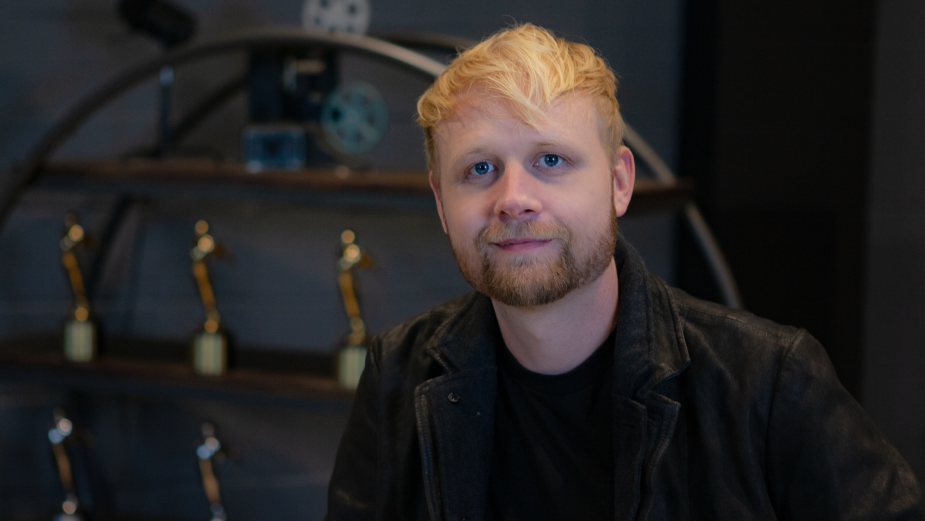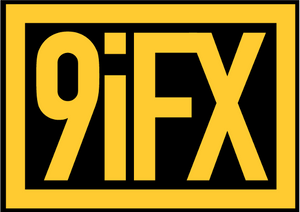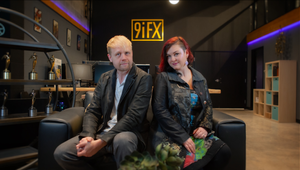
9iFX’s Michael Miller on Why the Post Landscape Will Shift in the Next 5 Years

Michael Miller is the founder, VFX supervisor and creative director for Portland-based post-production studio 9iFX. Founded in 2013, 9iFX is a full-service studio, specialising in VFX, 3D/2D animation, and motion graphics. Through complex motion graphics, high-end animation, and other pre and post-production capabilities (colour correction, sound design, editing etc.), the company has formed close creative relationships and worked on projects for brands such as Nike, The Emmys and Peloton.
Now a VFX supervisor with his own VFX boutique, Michael has experience as a compositor and VFX director, and has worked on many TV series. This includes NBC's ‘Grimm’, where he worked as a lead compositor and on-set supervisor, CW's ‘The Flash’ and Discovery Velocity's ‘Graveyard Carz’. He has also worked on feature films for the big screen and TV, while his catalogue of music video and commercial work covers brands like Puma, Intel, ESPN and adidas. Additionally, his on-set experience expands to camera operation at MTV and ESPN2, and assisting with graphics playback at the TNT television network.
His responsibilities at 9iFX also include being creative director, as he continues to work on high-end ad campaigns for some of the world’s biggest brands, as well as client relations and building new workflow pipelines for the company. To discuss his career journey so far, how 9iFX came about and the scary-yet-fun experience of seeing how quickly the world is changing with new technologies, LBB’s Ben Conway caught up with Michael for a chat.
LBB> What creative content inspired or interested you most when you were growing up? Do any TV shows, films and ads stand out to you?
Michael> I was always a fan of the ‘Back to the Future’ trilogy. I used to set up my VHS home video camera to record episodes of the show ‘Movie Magic’, which would break down how the special effects were being done in the ‘80s and ‘90s. Even though my studio is digital, I love any chance to push things practically and will often try to enhance something captured in-camera, versus creating it afterwards. ‘Back to the Future’ embodies all of my childhood dreams. Though, now I'm probably relating more to Doc than Marty.
LBB> When did the possibility of working in the VFX/advertising world appear to you? How was your journey into this industry?
Michael> As a kid, I was introduced to filmmaking when my parents helped get me into extra roles. I was in the teen movie ‘Drive Me Crazy’, ‘Touched by an Angel’ and Disney's ‘Johnny Tsunami’ to name a few. As a photo double on a TV movie, I became close with the director and his son. I was always interested in films that needed big effects and often made home movies using practical special effects and camera tricks. We ended up moving out of state, so my movie aspirations were put on pause until I hit college where I got a student copy of Adobe After Effects and started making movies that needed VFX to tell the story. As I posted my test videos online, the VFX clips gained traction until a director out of LA needed some help on his film starring a name actor. After successfully completing that project, I had created enough shots to build a portfolio and realised I could get paid to do this!
I later made a short film that was entered into a local film festival where a commercial director was impressed with my work and invited me to tour their studio. That was where I worked on some of my first feature films and national commercials as a VFX compositor.
LBB> When and why did you start 9iFX? How was the process of setting the company up? Can you share some of your initial goals and motivations?
Michael> After working on NBC's ‘Grimm’, I worked with the team to build the VFX pipeline for the studio. This gave me crucial team building/studio building experience and artist connections that played a big part in the decision. As the show neared its fifth season, I saw the writing on the wall and knew it was time to start preparing for the launch of my studio. Over the summer break - our off-season - I pulled the ‘Grimm’ crew together and teamed up with a budding director to work on some music videos to test out our post-production pipeline. Once we were set up, like clockwork, a big campaign for Puma landed in our lap and 9iFX was formed. It started with me ‘freelancing freelancers’ out of my kitchen until we moved into our first office.
LBB> How has the industry changed since you started - and even since 9iFX was founded? How have you adapted 9iFX to these changes?
Michael> The expansion of remote work and the increase in internet speeds has opened up the possibility of working with clients and projects from all over the world. In the beginning, we were very focused on the clients and projects we could source locally, but now, we have clients and artists all over the US and in Europe and Latin America as well.
Cloud-based rendering has been a game changer for us, it gives artists full render farm capabilities, which used to require thousands of dollars to have access to. We still have an in-house render farm, but having cloud-based as a backup is very convenient.
LBB> What is the creative/ad scene like in Portland? How does the city influence you both in and out of work?
Michael> Portland is home to a number of large creative agencies, the biggest of which is Wieden & Kennedy. As a result, there is a large plethora of small to medium-sized agencies as well. Portland is also home to the longest-running advertising industry group in the country – the Portland Ad Fed – so it’s a surprisingly built-out creative community for such a small city.
In addition, there are a handful of VFX/post houses all specialising in specific niches. Once upon a time, they were all pretty competitive with each other. I had made it my personal mission to shift the attitude, or at least to not give in to it. I made a strong effort to know all the studio owners and ensure that, even though we are in the same field, we can work together to put Portland on the map. Since then, a lot of the attitude has shifted naturally. All the VFX studio owners know each other and we will refer each other for jobs when one is maxed out or doesn't specialise in a specific type of skill.
LBB> What were some of your pivotal early projects and what are some of the commercial projects that you’re proudest of?
Michael> Besides Grimm and our first project for 9iFX (Puma), there have been so many. And each one creates a milestone that ends up pushing the studio to a new level. The Nike ‘LBJ17’ campaign was a big break into Nike projects that led to some great partnerships and portfolio pieces.
One project we did, was the first big project with on-set supervision that we were able to work on when they first started lifting covid restrictions. It was for Nike Ultrabreathe, a line of women’s athletic apparel, and we were brought in to do on-set supervision and VFX by the awesome team over at BlueOx Films. This spot was fun because it showed off a wide skillset of different animation styles, with 2D, 3D and stop-motion animation represented in the piece. I also got to play with a huge motion control rig, which is always fun.
Another big one was when we woke up to an email from VH1 asking us to bid on the ‘RuVeal’ campaign for season 13 of RuPaul’s DragRace. We were brought on to develop creative with their team, design the overall look of the campaign, and be the VFX/post house. We handled editing, colour, on-set supervision, 3D digital sets, motion graphics and greenscreen work. We delivered over 50 unique 30-second edits with custom aspect ratios for different social media platforms, and we completed the entire project in just one month.
LBB> How does TV work differ from commercial work - do they fulfil you in different ways?
Michael> What I really enjoy about non-episodic [content] is the variety. It's great to make monsters all day but after a few years, I'm glad to switch things up. Now our studio gets to work on non-traditional media, like digital displays for Time Square, motion-captured dancers applied to robots that get projected onto 30-foot-tall holograms, projection mapping animation onto old architectural buildings, playing with AR and 3D scanning.
On the commercial side, we have a lot more creative input. Clients regularly hire us to do all the creative direction and design, and we often take on the full project from concept to final delivery. That's not typically needed for episodic. By being a post house that specialises in VFX, we really get to stretch our talents in many areas and guide our clients into creating some cool stuff - without the limitations of a typical editorial house. Our clients know that we are there for them to get a particular task done while also knowing we can handle it if the scope changes drastically.
LBB> What’s the next big thing in the VFX world? What trend or innovation is on the horizon?
Michael> AI is going to change a lot of how we do things. This will affect most industries. It will remove a lot of the tedious or laborious tasks, like rotoscoping, clean plating, etc. and put the abilities of high-quality VFX into the hands of a wider user base. An editor will be able to do a lot more on their own without needing to bring in a roto/paint person. I do feel the whole landscape will shift within the next five years as this technology advances.
LBB> Looking at the broader industry, what gets you really excited and what frustrates you? What could the industry be doing better?
Michael> It's hard to say ‘the industry’ - really, there are lots of sub-industries: Traditional VFX for film and TV, high-end motion graphics for top-tier creative agencies, explainer videos for start-ups, product renderings or lifestyle videos for brands, show packages for docu-TV, environment creation for LED walls…
What I enjoy is seeing how they all tie together and are advancing so quickly. Game engines are now being used for live production, 3D camera tracking can be captured in-camera, motion tracking body suits are getting better and cheaper, and photogrammetry and 3D scanning is more readily available. The world is moving very fast and it's both exciting and scary to watch.
LBB> Outside of work, what do you do to decompress or stay fresh?
Michael> I like working with my hands and getting dirty. Mostly remodelling my house, reworking my yard, fixing my friends’ houses… Give me a hammer, I’ll build it. Basically, getting far away from a computer screen is super important, especially in an industry that pushes for long hours.
LBB> And what drives and motivates you in work and in your life?
Michael> My wife/business partner - my partner in all things. She surely does her job to push me further. She has been the consistent thing that has motivated me through all the years. Every other motivator has shifted over time. When I first started, it was about making the coolest effect, pushing my skills and making things look as epic as I could. Then it became about how big of a project it was, then about adding the best-known brands to my belt, then building our team, optimising our operations and creating a really cool place to work.
I keep evolving and rediscovering my job and my life in general, but my wife is the one constant that has stuck through all the change.













